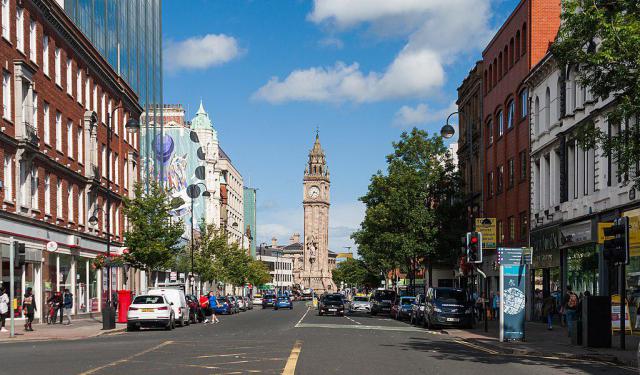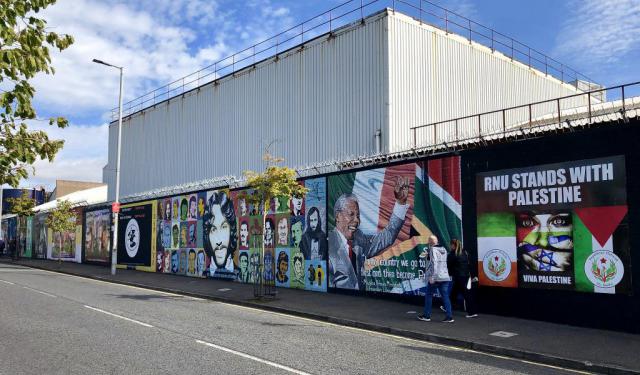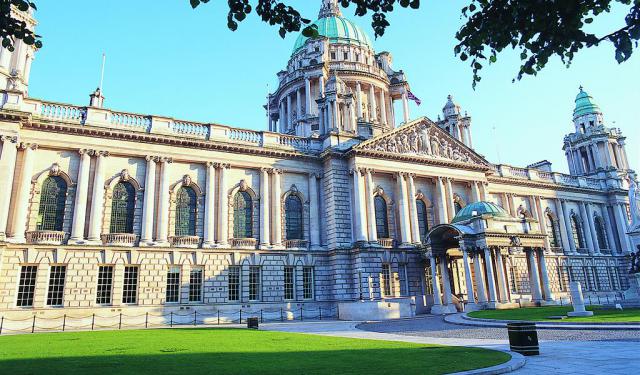St. Malachy's Church, Belfast
Nestled just steps from Belfast City Hall, Saint Malachy’s Church offers visitors a peaceful haven amid the city’s energetic centre. As the third‑oldest continuously used Catholic church in Belfast, it was completed in 1844. Designed by Waterford‑born architect Thomas Jackson in a distinctive Tudor Revival or “Elizabethan‑Gothic” style, its red‑brick exterior is crowned with castellated parapets and twin octagonal turrets, evoking the romantic feel of a small castle rather than a traditional Gothic cathedral.
Stepping inside, visitors are greeted by one of Northern Ireland’s most exquisite interiors. The star attraction is the fan‑vaulted plaster ceiling, inspired by the Henry VII Chapel at Westminster Abbey-so delicately ornate that it’s often likened to a wedding cake turned inside‑out. Below, the sanctuary’s blue‑toned mosaic floor features a pelican motif, symbol of Christ’s sacrifice, with marble altar rails and pulpit-replacements from a 1926 renovation-complementing the overall elegance. Painted over in the mid‑20th century, the sanctuary’s stencilling was meticulously restored during a major refurbishment in 2008–09, reviving the church’s vibrant colours.
Beyond its stunning architecture, Saint Malachy’s serves as a living centre of worship and community. Its interior houses side altars dedicated to Saint Joseph and the Blessed Virgin Mary, along with statues of beloved saints, creating a deeply contemplative atmosphere. Best visited during quieter times, the church provides a serene retreat where sunlight streams through stained‑glass windows, illuminating its peaceful ambiance.
Stepping inside, visitors are greeted by one of Northern Ireland’s most exquisite interiors. The star attraction is the fan‑vaulted plaster ceiling, inspired by the Henry VII Chapel at Westminster Abbey-so delicately ornate that it’s often likened to a wedding cake turned inside‑out. Below, the sanctuary’s blue‑toned mosaic floor features a pelican motif, symbol of Christ’s sacrifice, with marble altar rails and pulpit-replacements from a 1926 renovation-complementing the overall elegance. Painted over in the mid‑20th century, the sanctuary’s stencilling was meticulously restored during a major refurbishment in 2008–09, reviving the church’s vibrant colours.
Beyond its stunning architecture, Saint Malachy’s serves as a living centre of worship and community. Its interior houses side altars dedicated to Saint Joseph and the Blessed Virgin Mary, along with statues of beloved saints, creating a deeply contemplative atmosphere. Best visited during quieter times, the church provides a serene retreat where sunlight streams through stained‑glass windows, illuminating its peaceful ambiance.
Want to visit this sight? Check out these Self-Guided Walking Tours in Belfast. Alternatively, you can download the mobile app "GPSmyCity: Walks in 1K+ Cities" from Apple App Store or Google Play Store. The app turns your mobile device to a personal tour guide and it works offline, so no data plan is needed when traveling abroad.
St. Malachy's Church on Map
Sight Name: St. Malachy's Church
Sight Location: Belfast, Ireland (See walking tours in Belfast)
Sight Type: Religious
Sight Location: Belfast, Ireland (See walking tours in Belfast)
Sight Type: Religious
Walking Tours in Belfast, Ireland
Create Your Own Walk in Belfast
Creating your own self-guided walk in Belfast is easy and fun. Choose the city attractions that you want to see and a walk route map will be created just for you. You can even set your hotel as the start point of the walk.
Belfast Introduction Walking Tour
For over a century, the political situation of Belfast, the capital of Northern Ireland, has been the source of strife, first between the Crown-loyal Protestants and Irish Catholics, and more recently between the United Kingdom and the European Union.
Sitting on the banks of the River Lagan where it meets the Irish Sea, the city owes its name to this coastal condition, with "Belfast"... view more
Tour Duration: 2 Hour(s)
Travel Distance: 3.8 Km or 2.4 Miles
Sitting on the banks of the River Lagan where it meets the Irish Sea, the city owes its name to this coastal condition, with "Belfast"... view more
Tour Duration: 2 Hour(s)
Travel Distance: 3.8 Km or 2.4 Miles
The Troubles and Peace Process Landmarks
Decades past the official end of The Troubles in Belfast, the price of peace in Northern Ireland remains high. One of the means with which to secure it, back in 1969, was erecting a wall to physically separate the capital's warring Protestant and Catholic communities. Known since as the Peace Wall, the structure has become a popular tourist attraction for the multiple murals painted thereon... view more
Tour Duration: 1 Hour(s)
Travel Distance: 2.1 Km or 1.3 Miles
Tour Duration: 1 Hour(s)
Travel Distance: 2.1 Km or 1.3 Miles
Belfast Victorian Architecture Jewels
Described as “modestly scaled, undemonstrative, somewhat solid in aspect, and usually restrained (sometimes even austere) in its use of external decoration”, the urban landscape of Belfast has been influenced by the demands of shipbuilding and linen industry, much as transitioning between culture, arts, commerce, and education. Still, the architectural spectrum of the city is quite broad and... view more
Tour Duration: 2 Hour(s)
Travel Distance: 2.9 Km or 1.8 Miles
Tour Duration: 2 Hour(s)
Travel Distance: 2.9 Km or 1.8 Miles






